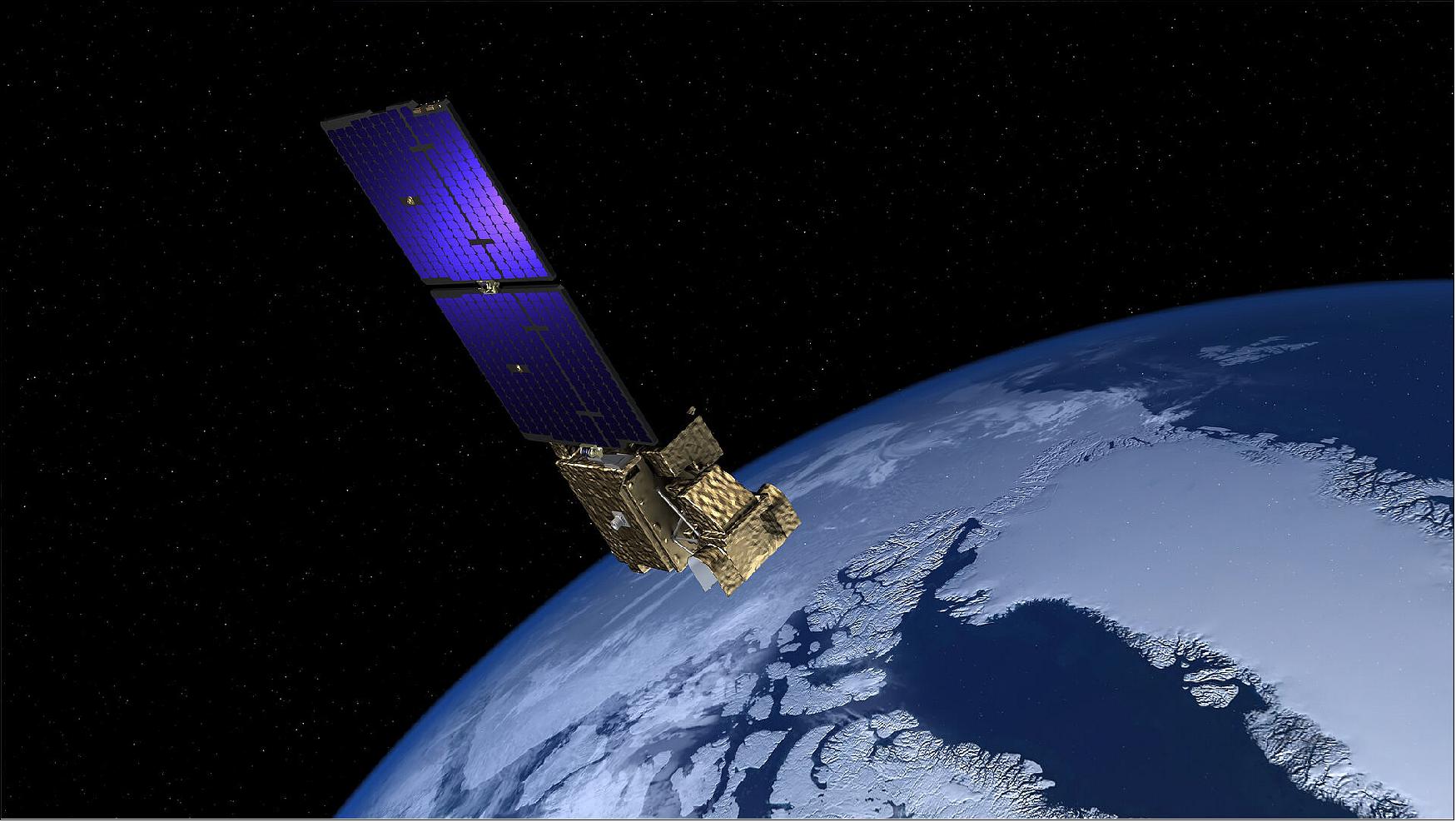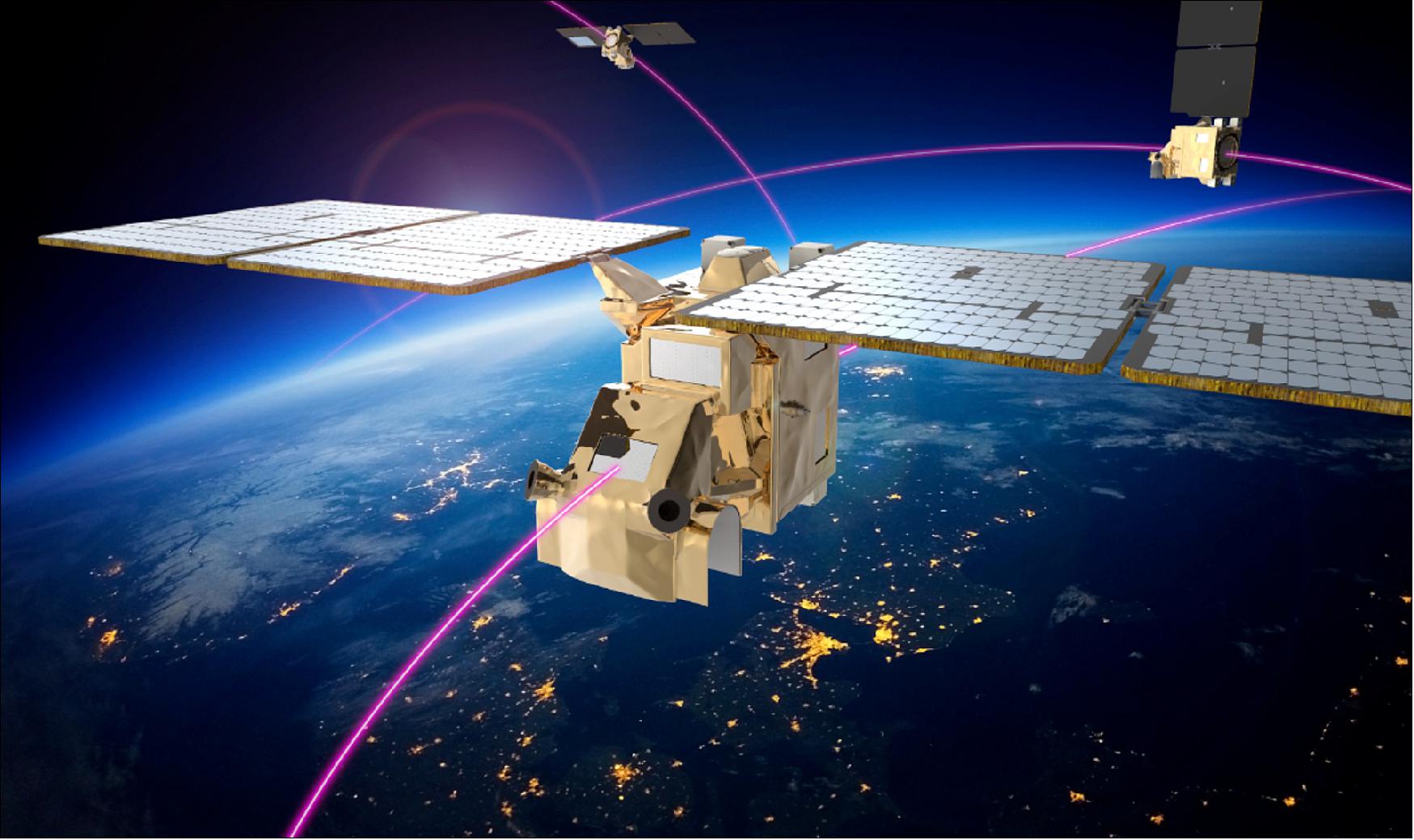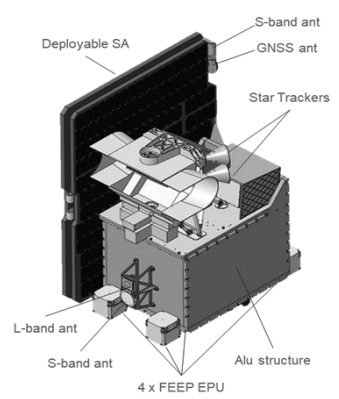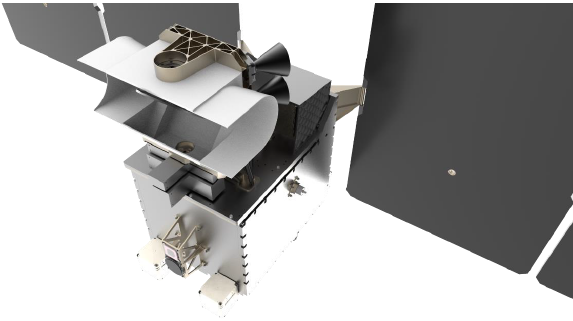AWS (Arctic Weather Satellite)
EO
ESA
Atmosphere
Atmospheric Temperature Fields
The Arctic Weather Satellite (AWS), is a planned constellation of meteorological microsatellites, owned by the European Space Agency (ESA). The program aims to build on existing Arctic monitoring satellites, such as MetOp and Metop SG, and provide precise, short-term weather forecasts for the Arctic region.
Quick facts
Overview
| Mission type | EO |
| Agency | ESA, EUMETSAT |
| Mission status | Approved |
| Measurement domain | Atmosphere |
| Measurement category | Atmospheric Temperature Fields, Atmospheric Humidity Fields |
| Measurement detailed | Atmospheric specific humidity (column/profile), Atmospheric temperature (column/profile) |
| Instruments | AWS Instrument |
| Instrument type | Atmospheric temperature and humidity sounders |
| CEOS EO Handbook | See AWS (Arctic Weather Satellite) summary |

Summary
Mission Capabilities
Each AWS satellite will carry a single instrument, a cross-track microwave radiometer, known as the AWS Microwave Radiometer (MWR (AWS) or MWR). MWR consists of a rotating antenna, which focuses incoming radiation onto one of four feedhorns and four receivers. Each of the feedhorns is directed to a slightly different point on ground, which will be re-mapped in on-ground processing. It aims to provide precise weather forecasting capabilities for the Arctic region.
Performance Specifications
MWR operates in 19 bands (see Table 1), covering a frequency range of 50 - 325 GHz, while the radiometer antenna will scan at a continuous speed of around 45 RPM, providing a spatial resolution range of 8.5 - 40 km at nadir.
AWS is planned to operate in a sun-synchronous low Earth orbit (LEO), with an altitude of approximately 600 km, an inclination of 97.79°, an orbital period of 97 minutes, and a repeat cycle of three days.
Space and Hardware Components
The AWS bus is based on the OGB InnoSat platform, a simple selective redundant microsatellite platform, with some significant improvements. The satellite bus will be three-axis stabilised, with a planned launch mass of approximately 120 kg. The platform will have dimensions of 1.0 m x 0.7 m x 0.8 m, with power consumption of 120 W and a planned mission lifetime of 5 years.
For radiofrequency (RF) communications, payload data will be transmitted in L-band with a data rate of 1500 kbps, while tracking, telemetry and command (TT&C) will be transmitted in S-band, at a data rate of 4000 kbps. For the satellite attitude and orbit control system (AOCS), the bus carries four field-emission electric propulsion (FEEP) thrusters, each providing up to 1.2 mN of thrust at 160 W.
Overview
A March 2021 article from ESA, Contract signed to build Arctic weather satellite1), explains the purpose of the AWS mission:
‘In response to the need for satellite data to be received more frequently in support of faster weather forecasting updates in the Arctic, ESA has signed a contract with OHB Sweden to build a prototype satellite for the AWS mission.
‘This prototype is the forerunner of a potential constellation of satellites that would supply an almost constant stream of temperature and humidity data from every location on Earth – allowing, for the first time, for very short-range weather forecasting, or ‘nowcasting’, in the Arctic. Meteorologists will also use the mission to improve weather forecasts around the world.
‘Accurate weather forecasts are an essential part of everyday life, used from simply deciding what clothes to wear to planning crop harvesting, ship routing and managing renewable energy resources.

The article1) goes on to explain the broader context in which the AWS mission operates:
‘Today, satellites, both those in geostationary orbit and in polar orbit, provide a wealth of information that meteorologists use routinely to forecast the weather, however, the monitoring of the Arctic remains insufficient.
‘Europe’s Meteosat geostationary satellites positioned 36,000 km above the equator return images every 15 minutes over the full Earth and every five minutes over Europe, they have no visibility of higher latitudes, closer to the poles, and so cannot be used for Arctic weather forecasting.
‘While the MetOp satellites do return data over the poles as they circle Earth from pole to pole in a lower orbit, they need up to 24 hours to achieve global coverage.
‘By providing global measurements of atmospheric temperature and humidity with frequent revisit times, the polar-orbiting Arctic Weather Satellite mission will complement MetOp and its counterpart US NOAA Joint Polar Satellite System. This will improve weather forecasts specifically in the Arctic, which has so far been lacking the data needed for short-term forecasts.

Finally, the article1) outlines the eventual plans for a constellation and the commitment of the agencies involved:
‘The Arctic Weather Satellite mission is foreseen as an eventual constellation – but as a first step, ESA has now put in place a contract to develop, build, launch and operate a prototype satellite. This also embraces the New Space approach by proving new concepts in a cost-effective and timely manner.
‘The contract, which is worth over €32 million, was signed today by Toni Tolker-Nielsen, ESA’s Acting Director of Earth Observation Programmes and Benoit Mathieu, Managing Director of OHB Sweden. Mr Tolker-Nielsen said, “The Arctic Weather Satellite development contract demonstrates ESA’s continued commitment to the establishment of novel, state-of-the-art meteorological satellite systems, while also showcasing what can be achieved with a cost-effective, New Space approach.”
‘The satellite will carry a 19-channel cross-track scanning MWR (Microwave Radiometer) on a swath of 1870 km, providing high-resolution humidity and temperature soundings of the atmosphere in all weather conditions in the range of (10-40 km).
‘OHB Sweden leads the industrial consortium, which includes Omnisys Sweden as the prime contractor for the microwave radiometer and Thales Alenia Space as prime contractor for the ground segment. The industrial team includes 31 companies, including 14 small and medium-sized enterprises from 12 ESA Member States.
‘Benoit Mathieu added, “This is the third mission relying on our Innosat platform. With this contract, OHB Sweden’s Innosat platform proves its New Space character suitable for a cost-effective and reliable Arctic Weather Satellite constellation and beyond.”
‘Looking forward, ESA would develop the envisaged constellation in cooperation with EUMETSAT, along the same agreement that led to the implementation of the generations of Meteosat and MetOp satellites.
‘Phil Evans, Director General of EUMETSAT, said, “We welcome today’s signature, as EUMETSAT is committed to working with ESA to evaluate the Arctic Weather Satellite in-orbit data. In addition to the observations from our Second Generation of MetOp satellites, we would expect any future Arctic Weather Satellite system to have a positive impact on meteorological applications, from regional and global numerical weather prediction to nowcasting in the Arctic region, where it will bring important and missing observations.
‘“EUMETSAT and ESA will also work together in assessing the technical feasibility and cost of a future operational constellation of such Arctic Weather Satellites which, if agreed by our Member States, would be implemented by EUMETSAT.”’
Spacecraft
The AWS bus, shown in Figure 3, is based on the OGB InnoSat platform, a simple selective redundant microsatellite platform, with some significant improvements.6) The InnoSat platform has demonstrated flight heritage from as recently as 2021, with the GMS-T mission, as well as decades of experience with other microsatellite missions, such as Astrid 1/2 (1995/1998), Odin (2001), SMART-1 (2003) and PRISMA (2010).
The satellite bus will be three-axis stabilised, with a planned launch mass of approximately 120 kg. The platform will have dimensions of 1.0 m x 0.7 m x 0.8 m, with power consumption of 120 W and a planned mission lifetime of 5 years. The bus will use an electric propulsion system to reach its planned low Earth orbit (LEO), as well as for end of life (EOL) deorbiting, and for collision avoidance should the need arise. The platform will feature deployable fixed-angle solar arrays. For radiofrequency (RF) communications, payload data will be transmitted in L-band, with a data rate of 1500 kbps, while tracking, telemetry and command (TT&C) will be transmitted in S-band, at a data rate of 4000 kbps.
For the satellite attitude and orbit control system (AOCS), the bus carries four field-emission electric propulsion (FEEP) thrusters, each providing up to 1.2 mN of thrust at 160 W. The AWS satellite is designed to be able to fulfil its mission with only three operable FEEP thrusters. These thrusters enable absolute pointing error below 290’’, attitude control of approximately 3°/min and change in orbit velocity of up to 310 ms-1. Attitude determination will be enabled by two star trackers, with absolute attitude knowledge error along any axis of less than 190’’.

Mission Status
May 18, 2022: With Arctic aviation and maritime activity on the rise, Europe and Canada are taking the lead in developing weather satellites to gather global data and improve observation of the Earth’s northernmost latitudes. 2)
A consortium led by OHB Sweden AB is developing a prototype for the European Space Agency’s AWS, a proposed constellation of 16 small satellites in polar orbit to gather weather data, under a 32.5 million Euro (USD 34.8 million) European Space Agency contract awarded last year. The prototype will be equipped with a microwave radiometer being developed by AAC Omnisys. Thales Alenia Space is the prime contractor for the AWS ground segment.
The Canadian Space Agency, meanwhile, is working with Environment and Climate Change Canada and Natural Resources Canada on a two-year campaign to evaluate the cost and potential benefits of a proposed Arctic Observing Mission (AOM).If approved, the AOM would send two satellites into highly elliptical orbits to maximise their view of northern regions while gathering data on meteorological conditions, greenhouse gases, air quality and space weather.
April 29, 2022: GomSpace to deliver the Mission Control System that KSAT will use to operate the AWS. Today, GomSpace signed a contract to develop, deliver and support the Mission Control System that KSAT will use to operate the AWS mission. 3)
The contract value is 10 MSEK and the majority of work will be done this year and next year.
The AWS is a project funded by the European Space Agency with the purpose to gather atmospheric data for meteorology in the Arctic region. The prime contractor is OHB Sweden and Thales is responsible for the ground segment.
April 5, 2022: As part of a consortium with ESA, OHB Sweden and Thales Alenia Space, KSAT will provide a one-stop solution for all operational activities for the AWS program. 4)
The Consortium is led by OHB Sweden who will build the AWS prototype-flight model and has contracted Thales Alenia Space to provide the Ground Segment.
KSAT will serve as a subcontractor to Thales, providing the Consortium with a single interface to handle all of the missions' routine operational needs.
May 6, 2021: RUAG Space has been awarded the contract to provide the power system for the prototype of the AWS radiometer instrument. The mission’s goal: to enable precise, short-term weather forecasts also in the Arctic. 5)
The contract includes an option for 16 additional flight models for the planned AWS constellation. The prototype for the AWS mission currently being developed by ESA with OHB Sweden as Mission prime is the precursor to a potential satellite constellation that would provide a near-constant stream of temperature and humidity data from anywhere on Earth. This would make very short-term weather forecasts – known as “now casting” – in the Arctic possible for the first time and would allow better prediction of storms or extreme weather conditions. OHB Sweden leads the industrial consortium for the AWS mission. Omnisys Instruments in Sweden is the instrument prime contractor from which RUAG Space has now received a contract to supply the power system for the prototype’s radiometer instrument including the design, manufacturing, testing and delivery.
With the mission, ESA is embracing the New Space approach. Anders Linder, head of the Electronics Product Group at RUAG Space, comments: “What makes AWS distinctive as an ESA project is that it embraces the New Space way-of-working. This means that cost-effective automotive grade components will be used, and agile development methods applied. Our team is determined to showcase what can be achieved by adopting a state-of-the-art approach here. We are excited to move forward with our customer Omnisys Instrument Sweden and work together with the entire AWS consortium for a successful mission.”
RUAG Space’s Power System is set to be delivered in Q4 2022. The now ordered prototype is planned to be followed-up by a constellation of 16 AWS satellites. Subject to a follow-up decision after the prototype, the constellation would be implemented with the European Organization for the Exploitation of Meteorological Satellites EUMETSAT according to the cooperation model established with the Meteosat and MetOp satellites.
Sensor Complement
Each AWS satellite will carry a single instrument, a cross-track microwave radiometer, known as the AWS Microwave Radiometer (MWR(AWS) or MWR), shown below in Figure 4.

MWR consists of a rotating antenna, which focuses incoming radiation onto one of four feedhorns and four receivers. Each of the feedhorns will point to a slightly different point on ground, which will be re-mapped in on-ground processing. MWR operates in 19 bands (See Table 1), covering a frequency range of 50 - 325 GHz, while the radiometer antenna will scan at a continuous speed of around 45 RPM, providing a spatial resolution range of 8.5 - 40 km at nadir.
As a complementary mission to the existing polar-orbiting meteorological satellites, such as MetOp and MetOp SG, MWR builds on the sensing capabilities of the Microwave Sounder (MWS) carried by MetOp SG. In doing so, channels below 50 GHz are dropped, and the 229 GHz receiver has been substituted by one at 325 GHz. Another key difference to MWS is that the complex optical system used by MetOp SG is no longer in use, and spatial separation of receivers has replaced the use of frequency selective materials.
The spatial separation of the MWR receivers allows the instrument to be much more compact, as well as reducing losses in the receiver chain, therefore increasing sensitivity. Compared to MWS, the instrument front-end will be operated at a lower temperature, further improving sensitivity. As well as this, the instrument is planned to use a state-of-the-art short-term stability and calibration accuracy system, with a fully protected wedge shaped calibration target.
MWR is planned to have a swath width of 1870 km, covering the polar zones, without gaps, and aims to measure temperature and humidity profiles, primarily over the arctic region. As such the instruments primary mission products are: atmospheric temperature, cloud ice, cloud ice (total column), integrated water vapour (IWV), precipitation intensity at surface and specific humidity. These mission products, when generated by the planned constellation of AWS satellites, will enable short-term, precise Arctic weather forecasts.
Channel | Frequency (GHz) | Bandwidth (MHz) | Noise Equivalent Delta Temperature (K) | Footprint (km) | Utilisation |
11 | 50.3 | 180 | <0.6 | ≤ 40 | Temperature sounding |
12 | 52.8 | 400 | <0.4 | ≤ 40 | Temperature sounding |
13 | 53.246 | 300 | <0.4 | ≤ 40 | Temperature sounding |
14 | 53.596 | 370 | <0.4 | ≤ 40 | Temperature sounding |
15 | 54.4 | 400 | <0.4 | ≤ 40 | Temperature sounding |
16 | 54.94 | 400 | <0.4 | ≤ 40 | Temperature sounding |
17 | 55.5 | 330 | <0.5 | ≤ 40 | Temperature sounding |
18 | 57.290344 | 330 | <0.6 | ≤ 40 | Temperature sounding |
21 | 89 | 4000 | <0.3 | ≤ 20 | Window and Cloud detection |
31 | 165.5 | 2800 | <0.6 | ≤ 10 | Window/humidity sounding |
32 | 176.311 | 2000 | <0.7 | ≤ 10 | Humidity sounding |
33 | 178.811 | 2000 | <0.7 | ≤ 10 | Humidity sounding |
34 | 180.311 | 1000 | <1 | ≤ 10 | Humidity sounding |
35 | 181.511 | 1000 | <1 | ≤ 10 | Humidity sounding |
36 | 182.311 | 500 | <1.3 | ≤ 10 | Humidity sounding |
41 | 325.15±1.2 | 800 | <1.7 | ≤ 10 | Humidity sounding/cloud detection |
42 | 325.15±2.4 | 1200 | <1.4 | ≤ 10 | Humidity sounding/cloud detection |
43 | 325.15±4.1 | 1800 | <1.2 | ≤ 10 | Humidity sounding/cloud detection |
44 | 325.15±6.6 | 2800 | <1 | ≤ 10 | Humidity sounding/cloud detection |
Ground Segment
The AWS ground segment consists of three components, the Svalbard Ground Station (SGS), Monitoring and Control Segment (MCS) and Payload Data Ground Segment (PDGS). SGS is the main space to ground interface, and features both conventional S-band downlink for TT&C communications, and a novel L-band Digital Beam Forming Network, which allows the simultaneous electronic tracking of multiple satellites from a single antenna array, and is used for data downlink.
MCS contains most vital functions for the monitoring and control of the satellite, such as the Flight Dynamics System (FDS), which provides accurate, real-time graphical visualisation of spacecraft in orbit around the Earth. Finally PDGS processes, archives and disseminates payload data, processing instrument source packets up to Level-1b (calibrated and geolocated radiances), and distributing data to Eumetsat’s EUMETCast system, from where it will be distributed to end users.
Largely due to cloud-based mission infrastructure, all ground segment operations are centralised in an operations centre in Tromsø, Norway, which operates the entire system and provides 24/7 monitoring of the data processing chain.
References
1) ”Contract signed to build Arctic weather satellite,” ESA Applications, 09 March 2021, URL: https://www.esa.int/Applications/Observing_the_Earth/Meteorological_missions/Arctic_Weather_Satellite/Contract_signed_to_build_Arctic_weather_satellite
2) Debra Werner, ”Proposed constellations would enhance Arctic weather observations,” SpaceNews, 18 May 2022, URL: https://spacenews.com/proposed-constellations-would-enhance-arctic-weather-observations/
3) ”GomSpace to deliver the Mission Control System that KSAT will use to operate the Arctic Weather Sate,” GomSpace News, 29 April 2022, URL: https://gomspace.com/news/gomspace-to-deliver-the-mission-control-syste.aspx
4) ”KSAT to provide satellite operations as-a-service for ESA's Arctic Weather Satellite,” KSAT News, 5 April 2022, URL: https://www.ksat.no/news/news-archive/2022/ksat-to-provide-satellite-operations-for-esa-arctic-weather-satellite/
5) ”ESA’s new Arctic Weather Satellite flies with a power system by RUAG Space,” Geospatial World, 6 May 2021, URL: https://www.geospatialworld.net/news/esas-new-arctic-weather-satellite-flies-with-a-power-system-by-ruag-space/
6) “ESA - Arctic Weather Satellite.” European Space Agency, https://www.esa.int/Applications/Observing_the_Earth/Meteorological_missions/Arctic_Weather_Satellite. Accessed 14 December 2022.
7) “Arctic Weather Satellite, A Microsatellite Constellation for Improved Weather Forecasting in Arctic and Globally.” DigitalCommons@USU, https://digitalcommons.usu.edu/cgi/viewcontent.cgi?article=5087&context=smallsat. Accessed 14 December 2022.
8) “ESA Arctic Weather Satellite.” AAC Clyde Space, https://www.aac-clyde.space/case-studies/esa-arctic-weather-satellite. Accessed 14 December 2022.
9) “Start Space Missions ARCTIC WEATHER SATELLITE.” OHB Sweden, https://www.ohb-sweden.se/space-missions/arctic-weather-satellite. Accessed 14 December 2022
10) “ESA's new Arctic Weather Satellite flies with a power system by RUAG Space.” Geospatial World, 6 May 2021, https://www.geospatialworld.net/news/esas-new-arctic-weather-satellite-flies-with-a-power-system-by-ruag-space/. Accessed 14 December 2022.
11) “WMO OSCAR | Details for Instrument MWR (AWS).” WMO OSCAR, 11 April 2022, https://web.archive.org/web/20230628024513/https://space.oscar.wmo.int/instruments/view/mwr_aws. Accessed 14 December 2022.